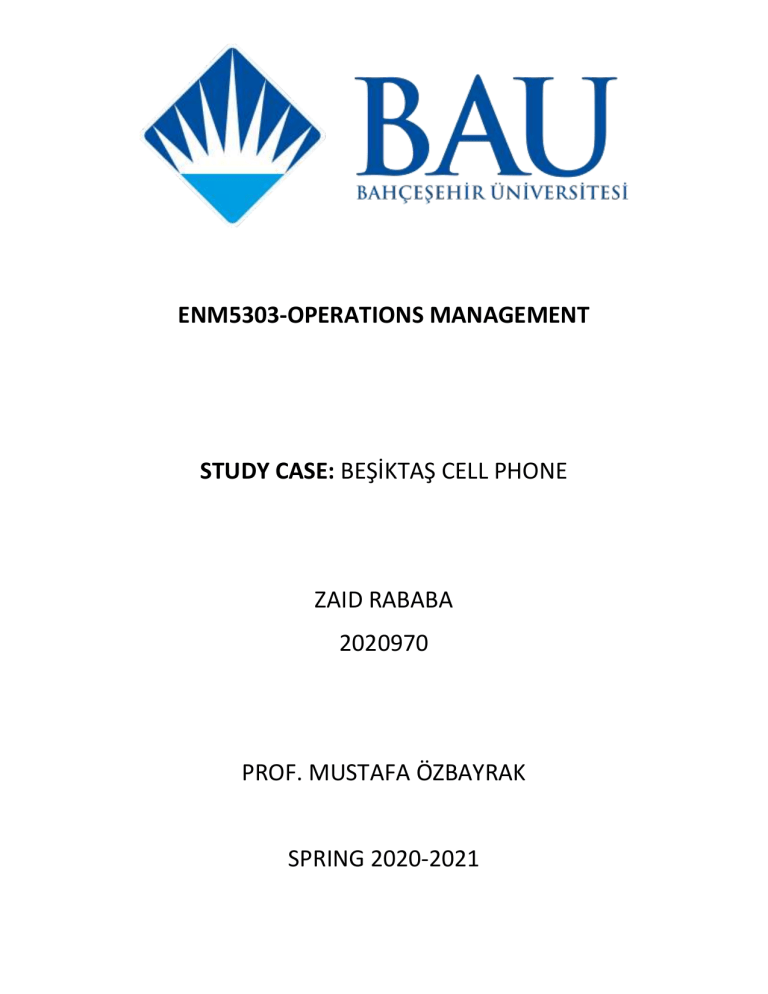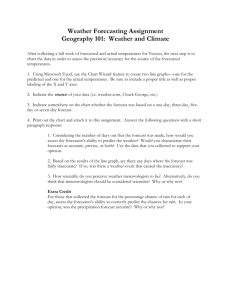
ENM5303-OPERATIONS MANAGEMENT STUDY CASE: BEŞİKTAŞ CELL PHONE ZAID RABABA 2020970 PROF. MUSTAFA ÖZBAYRAK SPRING 2020-2021 ORDERS RECEIVED BY MONTHS MONTH 2018 2019 2020 January 480 575 608 February 436 527 597 March 482 540 612 April 448 502 603 May 458 508 628 June 489 573 605 July 498 508 627 August 430 498 578 September 444 485 585 October 496 526 581 November 487 552 632 December 525 587 656 After reviewing the data, I am planning to make the forecast project by using Least Square Regression Method to get the linear function (as shown in the chart above) of our historical data. In order to get the linear function Y(t)= a + b*t We should first determine a & b values by the Least Square Method: X: Represents the month which is (t) in our equation. Y: Represents the monthly orders. N: Represents number of data. ∑ x(t) 1 2 3 4 5 6 7 8 9 10 11 12 13 14 15 16 17 18 19 20 21 22 23 24 25 26 27 28 29 30 31 32 33 34 35 36 666 y 480 436 482 448 458 489 498 430 444 496 487 525 575 527 540 502 508 573 508 498 485 526 552 587 608 597 612 603 628 605 627 578 585 581 632 656 19366 x^2 1 4 9 16 25 36 49 64 81 100 121 144 169 196 225 256 289 324 361 400 441 484 529 576 625 676 729 784 841 900 961 1024 1089 1156 1225 1296 16206 y^2 230400 190096 232324 200704 209764 239121 248004 184900 197136 246016 237169 275625 330625 277729 291600 252004 258064 328329 258064 248004 235225 276676 304704 344569 369664 356409 374544 363609 394384 366025 393129 334084 342225 337561 399424 430336 10558246 xy 480 872 1446 1792 2290 2934 3486 3440 3996 4960 5357 6300 7475 7378 8100 8032 8636 10314 9652 9960 10185 11572 12696 14088 15200 15522 16524 16884 18212 18150 19437 18496 19305 19754 22120 23616 378661 By applying the equations, we get these results: b= 36 ∗ 378661 − 666 ∗ 19366 = 5.248 = 5.25 36 ∗ 16206 − 6662 a= 19366 − 5.25 ∗ 666 = 440.819 = 440.82 36 So our final linear trend equation (Forecast Equation) is: 𝒀(𝒕) = 𝟓. 𝟐𝟓𝒕 + 𝟒𝟒𝟎. 𝟖𝟐 Now for year 2021 all what we have to do is simply apply the next months’ time into the equation which will be ranged from 37 to 48 in order to forecast the next 6 to 12 months. Month January February March April May June July August September October November December t 37 38 39 40 41 42 43 44 45 46 47 48 Forecast 635 640 646 651 656 661 667 672 677 682 688 693 Now after we forecasted the next months I think it will be better if we add the seasonality affect to our calculations by multiplying the forecasted value with the seasonality adjustment factor C which is calculated by the following: 1- Calculate C for each month of the previous years. 2- Take average of C for each month for the years 1,2, and 3. 3- Multiply the average C by the forecasted value for year 2021. 𝐶= 𝑎𝑐𝑡𝑢𝑎𝑙 𝑣𝑎𝑙𝑢𝑒 𝑓𝑜𝑟𝑒𝑐𝑎𝑠𝑡𝑒𝑑 𝑣𝑎𝑙𝑢𝑒 And now as we obtained the average seasonality factor for all of previous years the last step is to multiply it with the forecasted value for year 2021 to get the adjusted forecast value of how many cellphones should be produced for each month of the next year. Final Forecast For Year 2021 Month January February March April May June July August September October November December t 37 38 39 40 41 42 43 44 45 46 47 48 Forecast 635 640 646 651 656 661 667 672 677 682 688 693 AVG. C 1.089 1.008 1.049 0.984 0.999 1.039 1.007 0.917 0.914 0.963 0.991 1.040 Adjusted 692 645 678 641 655 687 672 616 619 657 682 721 Don’t forget that forecast is always wrong especially when going further to the future and need to be updated continuously after observing the actual order of the following month. References: ENM5303 Operations Management lecture notes made by Prof. Mustafa Özbayrak.



